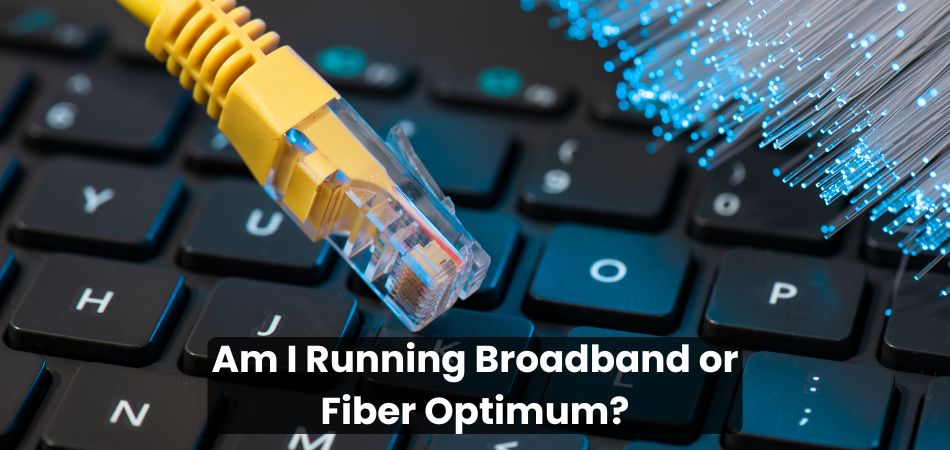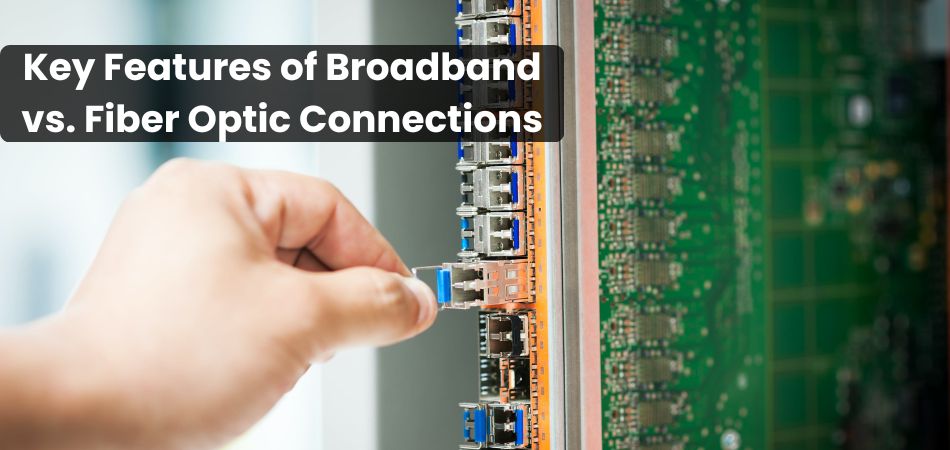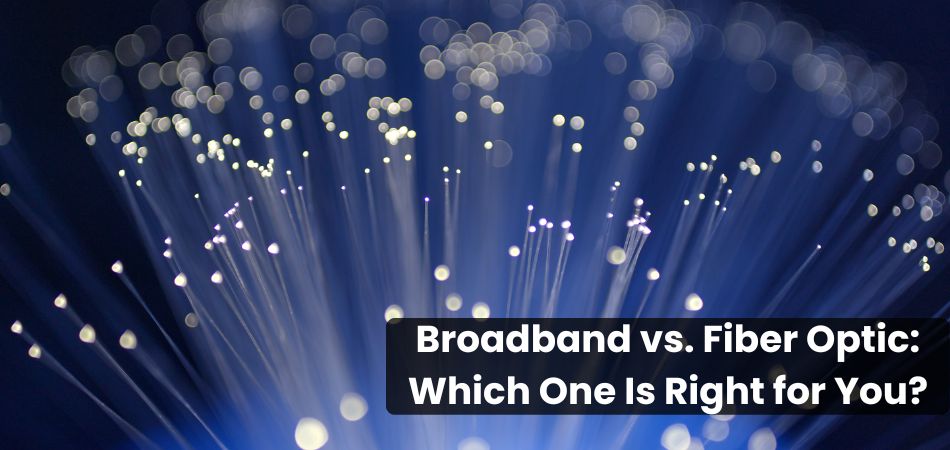Are you curious about the type of internet service you’re using? With so many options available, it can be extremely difficult to determine whether your connection is broadband or fiber-optic.
Knowing this difference is crucial, as it impacts your speed, reliability, and overall online experience. So, am I running broadband or fiber optimum? This is a question many ask but often struggle to answer.
To determine if you’re running broadband or fiber optimum, check your internet bill, inspect your modem/router, or run a speed test. Fiber offers higher speeds and stability, while broadband typically uses DSL or cable.
Stay tuned to learn practical tips that could make a big difference in your connectivity. Would you like to find out more? Keep reading to figure out the secrets of your internet connection.
Am I Running Broadband or Fiber Optimum? Tips to Identify Your Internet Service
Figuring out whether you’re using broadband or fiber-optic internet is essential for optimizing your online experience. Each connection type offers distinct advantages—broadband typically relies on DSL or cable, while fiber-optic internet delivers faster speeds through advanced fiber cables. Knowing the difference can help you assess your internet performance and decide if an upgrade is necessary.
Many users ask, “Am I running broadband or fiber optimum?” because it’s not always obvious. Internet speed, connection stability, and equipment can offer clues about your service type. Recognizing these differences allows you to troubleshoot issues effectively and make informed decisions about your internet plan.

If you’re unsure about your current internet setup, don’t worry. With a few simple steps, you can easily determine whether your connection is broadband or fiber-optic. Follow this step-by-step guide to accurately identify your internet service and ensure it matches your needs.
1. Check Your Internet Bill or Plan Details
Review your internet bill for terms like “fiber,” “DSL,” or “cable.” Fiber-optic plans often highlight high-speed capabilities (e.g., gigabit speeds). Broadband services may list DSL or cable as the connection type. Your provider’s website or customer service can also clarify this information.
2. Inspect Your Modem and Router
Fiber-optic internet typically uses an Optical Network Terminal (ONT) instead of a traditional modem. Broadband connections rely on standard modems or modem-router combos. Look for labels or model numbers and search online to verify the device type. This hardware check can quickly reveal your connection.
3. Test Your Internet Speed
Run a speed test using websites like Speedtest.net. Fiber-optic connections usually offer higher speeds (500 Mbps to 1 Gbps), while broadband often ranges between 25–200 Mbps. Consistently high speeds suggest fiber service, while lower speeds may indicate broadband. Compare your results with your plan’s advertised speeds.
4. Observe Your Connection Stability
Fiber-optic internet generally provides more stable and reliable performance. If you experience frequent buffering, lag, or disconnections, you might be on a broadband connection. Fiber connections are less prone to slowdowns during peak hours. Monitoring your connection stability can offer important clues.
5. Contact Your Internet Service Provider (ISP)
When in doubt, reach out to your ISP for direct confirmation. Customer service can quickly tell you whether you’re using broadband or fiber-optic internet. They can also recommend better plans if your current service isn’t meeting your needs. This step ensures accurate information straight from the source.
Difference Between Broadband and Fiber Optic Internet
Choosing between broadband and fiber-optic internet can significantly impact your online experience. Broadband typically uses DSL, cable, or satellite connections, while fiber-optic internet relies on advanced fiber-optic cables for faster and more reliable service. Below is a detailed comparison to help you know the key differences between these two types of internet connections.
| Feature | Broadband (DSL/Cable) | Fiber Optic Internet |
| Connection Type | Copper cables (DSL) or coaxial cables (cable) | Fiber-optic cables using light signals |
| Speed | 25 Mbps to 200 Mbps (varies by plan and location) | 500 Mbps to 1 Gbps+ for most plans |
| Reliability | Can slow down during peak hours | Highly stable with minimal disruptions |
| Latency | Higher latency, leading to potential lag | Very low latency, ideal for gaming and streaming |
| Availability | Widely available in urban and rural areas | Mainly available in urban and expanding areas |
| Installation Process | Simple installation with standard modems/routers | Requires an Optical Network Terminal (ONT) |
| Cost | Generally more affordable | Higher upfront costs but more value over time |
| Bandwidth Sharing | Shared with nearby users, causing slowdowns | Dedicated line reduces network congestion |
| Ideal For | Basic browsing, streaming, and casual gaming | Heavy streaming, gaming, remote work, large uploads/downloads |
Key Features of Broadband vs. Fiber Optic Connections
Being familiar with the distinct features of broadband and fiber-optic internet can help you choose the best option for your needs. Beyond speed and reliability, several unique aspects differentiate these two technologies. Let’s explore the key features that set broadband and fiber-optic connections apart.

Technology Behind the Connection
Broadband internet typically operates through copper-based cables, utilizing either DSL or coaxial lines for data transmission. This older infrastructure limits data transfer rates due to signal degradation over long distances. In contrast, fiber-optic internet transmits data as light signals through glass or plastic fibers, ensuring faster and clearer communication. This advanced technology allows fiber to handle higher data volumes without interference.
Symmetrical vs. Asymmetrical Speeds
Broadband services often provide asymmetrical speeds, meaning download speeds are much faster than upload speeds. This can be limiting for tasks like video conferencing or cloud backups that require higher upload capacity. Fiber-optic connections typically offer symmetrical speeds, providing equal download and upload performance. This feature is ideal for remote work, content creation, and real-time collaboration.
Resistance to Weather and Interference
Broadband connections, especially those using copper cables, are vulnerable to weather conditions and electromagnetic interference. Heavy rain, storms, or electrical disturbances can disrupt service and reduce performance. Fiber-optic cables, however, are immune to electromagnetic interference and weather-related disruptions. This durability ensures more consistent performance in various environmental conditions.
Scalability for Future Technologies
Broadband infrastructure has limited capacity to scale up as technology advances, often requiring significant upgrades for higher demand. Fiber-optic networks are inherently more scalable due to their ability to handle increasing bandwidth without needing major infrastructure changes. This makes fiber ideal for supporting future innovations like smart homes and 8K streaming. As technology evolves, fiber networks can easily adapt to growing data demands.
Environmental Impact
Broadband systems, particularly cable and DSL, consume more energy due to the need for signal amplification and frequent maintenance. The copper-based infrastructure also has a larger carbon footprint due to mining and production. Fiber-optic networks are more energy-efficient, using light signals that require less power for data transmission. This eco-friendly design contributes to lower energy consumption and a reduced environmental impact.
Simple Tools to Identify Your Internet Service Provider
Knowing your Internet Service Provider (ISP) can help you troubleshoot connection issues, upgrade your plan, or switch providers. Fortunately, several easy-to-use tools can quickly reveal your ISP details without needing technical expertise. Here are some simple methods to identify your internet provider effortlessly.
Use Online ISP Lookup Tools
Websites like WhatIsMyISP.com or IP Location can instantly detect and display your ISP information. These tools analyze your IP address to reveal the provider’s name and network details. Simply visit the website, and it will automatically generate your ISP information. This method is quick, free, and requires no downloads.
Check Router or Modem Settings
Accessing your router’s admin panel can provide details about your ISP. Open a browser and enter the default gateway IP (e.g., 192.168.1.1) to log in using your credentials. Once inside, look for network status or connection details, where the ISP’s name may be listed. This method is helpful for users who prefer checking their own network setup.
Review System Network Settings
On your computer or smartphone, navigate to the network settings to find details about your connection. For Windows, use the Command Prompt and type ipconfig /all to view network information. Mac users can check their network preferences for service details. This built-in method provides direct insights without needing external tools.
Broadband vs. Fiber Optic: Which One Is Right for You?
Choosing between broadband and fiber-optic internet depends on your specific internet needs and usage habits. Broadband, delivered through DSL or cable, is widely available and often more affordable, making it a practical choice for basic browsing, streaming, and casual gaming. However, its speeds and reliability can vary, especially during peak usage hours.

Fiber-optic internet offers significantly faster speeds and greater reliability by transmitting data through light signals in fiber cables. This makes it ideal for households or businesses with heavy internet usage, such as streaming in 4K, online gaming, video conferencing, or large file uploads. While fiber may have higher installation costs, it delivers long-term value with consistent, high-speed performance.
To decide which option is right for you, consider your internet usage, budget, and availability in your area. If you need ultra-fast, stable internet for work or entertainment, fiber-optic is the better choice. For basic internet needs, broadband remains a cost-effective and accessible solution.
Can Your Router Indicate If You’re on Fiber or Broadband?
Your router can provide valuable clues about whether you’re using fiber or broadband internet. Broadband connections, such as DSL or cable, typically use standard modems or modem-router combinations that connect through coaxial or telephone lines. In contrast, fiber-optic internet often requires an Optical Network Terminal (ONT) that connects directly to a specialized fiber-compatible router.
Inspecting your router’s ports and labels can reveal your connection type. If your router connects to a coaxial cable or telephone line, you’re likely using broadband. However, if it connects to an ONT device or directly to a fiber port using an Ethernet cable, it’s a strong indication that you have fiber-optic service. Some fiber routers may also be branded or labeled by fiber-specific providers.
Additionally, the router model number can offer insight into your internet type. Searching the model online can confirm whether it’s designed for fiber-optic or broadband connections. Learning about your router setup can help you better manage your internet service and optimize performance.
Frequently Asked Questions About Internet Connection Types
Figuring out your internet connection can be confusing with so many options available. To help clear up common concerns, here are five frequently asked questions about internet services and how to identify the right one for you. These answers will guide you in making informed decisions about your connectivity needs.
1. How Can I Improve My Internet Speed Without Upgrading My Plan?
You can boost your internet speed by repositioning your router to a central location and minimizing interference from other devices. Regularly restarting your modem and router can also improve performance. Additionally, limiting background apps and devices connected to your network can free up bandwidth.
2. Does My Internet Speed Depend on My Location?
Yes, your internet speed can vary based on your location and the available infrastructure. Urban areas typically have faster internet options like fiber, while rural regions may rely on DSL or satellite. Distance from your ISP’s central hub can also affect speed and reliability.
3. Can I Switch ISPs Without Changing My Equipment?
In some cases, you can switch ISPs without changing your equipment if the new provider uses the same connection type. However, switching from broadband to fiber may require a new router or modem. It’s best to confirm compatibility with your new ISP before making the switch.
4. Why Does My Internet Slow Down During Certain Times of Day?
Internet slowdowns during peak hours are often due to network congestion when many users are online. Broadband connections, especially cable, share bandwidth with nearby users, leading to slower speeds. Fiber-optic connections are less affected by peak usage times due to dedicated bandwidth.
5. Is Wired Internet Better Than Wi-Fi?
Wired internet connections typically offer faster and more stable speeds compared to Wi-Fi. Ethernet cables provide a direct, interference-free connection, ideal for gaming, streaming, and remote work. Wi-Fi is more convenient for mobility but can suffer from signal interference and slower speeds.
Final Thoughts
Choosing the right internet connection is essential for ensuring smooth online experiences, whether for work, streaming, or gaming. Knowing the differences between broadband and fiber-optic services helps you make informed decisions about your internet needs.
Factors like speed, reliability, and usage habits play a crucial role in determining the best option. If you’ve ever wondered, “am I running broadband or fiber optimum?” now you have the tools to find out. By identifying your current service, you can decide if it meets your demands or if an upgrade is necessary. Stay connected with the right internet for your lifestyle.
